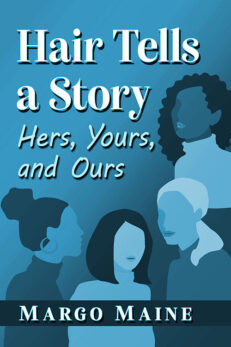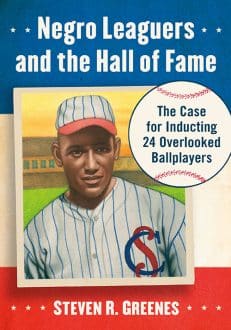Negro Leaguers and the Hall of Fame
$39.95
In stock
About the Book
Since 1971, 35 Negro League baseball players and executives have been admitted to the Hall of Fame. The Negro League Hall of Fame admissions process, which has now been conducted in four phases over a 50-year period, can be characterized as idiosyncratic at best. Drawing on baseball analytics and surveys of both Negro League historians and veterans, this book presents an historical overview of NLHOF voting, with an evaluation of whether the 35 NL players selected were the best choices. Using modern metrics such as Wins Above Replacement (WAR), 24 additional Negro Leaguers are identified who have Hall of Fame qualifications. Brief biographies are included for HOF–quality players and executives who have been passed over, along with reasons why they may have been excluded. A proposal is set forth for a consistent and orderly HOF voting process for the Negro Leagues.
About the Author(s)
Bibliographic Details
Steven R. Greenes
Format: softcover (7 x 10)
Pages: 280
Bibliographic Info: 30 photos, appendices, notes, bibliography, index
Copyright Date: 2020
pISBN: 978-1-4766-7268-7
eISBN: 978-1-4766-4111-9
Imprint: McFarland
Table of Contents
Preface 1
Introduction 3
Part One. History of the Hall of Fame Voting for the Negro Leagues 7
1. Phase 1: The Committee on Negro League Baseball Leagues (1971–1977) 9
2. Phase 2: The Veterans Committee (1978–1994) 18
3. Phase 3: A Quota System Is Implemented (1995–2001) 20
4. Phase 4: The Historians Take Over (2001–2006) 22
Part Two. Determining Hall of Fame Qualification of the Negro Leagues 31
5. The Twelve Rules 33
6. The Sources for Hall of Fame Analysis of the Negro Leagues Are Hiding in Plain Sight 45
7. WAR, Similarity Scores and Fielding Analysis Are Available for the Negro Leagues 53
8. Overview of Analytical Sources 57
Part Three. 24 Men Out—A Position by Position Analysis of the Voting to Date 59
9. Catcher 61
Worthy of Further Discussion 62
Bruce Petway 62; Frank Duncan, Jr. 63; George “Chappie” or “Rat” Johnson 64; Wabishaw “Doc” Wiley 65; Larry “Iron Man” Brown 66; Joe Greene 67; Quincy Trouppe 68
10. First Base 72
Worthy of Further Discussion 72
Edgar Wesley 72; George “Tank” Carr 73; Luke Easter 75; Bill Pettus 76
11. Second Base 79
Elwood “Bingo” DeMoss 79
Newton “Newt” Allen 81
Sammy T. Hughes 84
Worthy of Further Discussion 86
Frank “The Weasel” Warfield 86; Charlie Grant 87; Lorenzo “Piper” Davis 88; Bonnie a/k/a Barney Serrell 90; Marvin “Tex” Williams 91
12. Shortstop 93
Richard “Dick” Lundy 93
Grant “Home Run” Johnson 96
Walter “Dobie” Moore 99
Worthy of Further Discussion 102
Artie Wilson 102; James “Bus” (“Buz” or “Buzz”) Clarkson 104
13. Third Base 106
Oliver “The Ghost” Marcelle 106
George “Tubby” Scales 108
Worthy of Further Discussion 112
Alec (Alex) Radcliffe 112; Orestes “Minnie” Minoso 112
14. Outfield 115
Charlie “Chino” Smith 115
Burnis “Wild Bill” Wright 118
Spottswood Poles 122
Herbert “Rap” Dixon 124
Worthy of Further Discussion 127
Oscar “Heavy” Johnson 127; Hurley McNair 129; Clarence “Fats” Jenkins 130; Alejandro “El Caballero” (The Gentleman) Oms 131; Valentin Dreke 133; Chaney White 134; Clint “Hawk” Thomas 134; Sam “The Jet” Jethroe 135; Jimmie Lyons 135; Charlie Blackwell 135; Ted Strong 136; Bernardo Baro 136; Roy “Red” Parnell 136; George “Rabbit” Shively 137
15. Pitcher 139
Dick “Cannonball” Redding 139
John Donaldson 142
Bill Byrd 146
Chet Brewer 149
Worthy of Further Discussion 152
William Bell, Sr. 152; George Stovey 154; Jesse “Nip” Winters 155; William “Dizzy” Dismukes 156; Juan Padrón 156; Eustaquio “Bombin” Pedroso 157; Dave “Impo” Barnhill 158; Bill “Cannonball” Jackman 160; Stuart “Slim” Jones 161; Leroy Matlock 162; Bill Holland 162; Ted Trent 162; Phil Cockrell 162; Arthur “Rats” Henderson 163; Laymon Yokely 163; Barney “Brinquitos” Brown 163; Webster McDonald 164; Dan McClellan 164; George “Lefty” Wilson 164; Frank “Rawhide” Wickware 165; Walter Ball 165; Dave Brown 166; Roy Welmaker 166; Roosevelt Davis 166; Sam Streeter 167
16. Super Utility 169
John “The Black Bomber” Beckwith 170
Bill “Money” Monroe 174
Worthy of Further Discussion 177
Harry Buckner 177; Walter “Rev” Cannady 177; Sam Bankhead 179; Ted “Double Duty” Radcliffe 181
17. Manager 183
C.I. Taylor 183
“Candy Jim” Taylor 186
Worthy of Further Discussion 188
Dave Malarcher 188; Elander “Vic” Harris 189
18. Executive 193
Gus Greenlee 194
Ed “Chief” Bolden 198
Worthy of Further Discussion 188
Frank C. Leland 201
19. Pioneer/Overall Contribution 203
Bud Fowler 203
John “Buck” O’Neil 207
Part Four. A Path Forward 213
20. Conclusions 215
21. Reopening the Door 221
Acknowledgments 227
Appendix A: Current Negro League Hall of Famers 229
Appendix B: Negro League Hall of Fame Ballots 231
Appendix C: 1952 Pittsburgh Courier Experts’ Poll 233
Appendix D: 1952 Pittsburgh Courier “Fan Poll” 235
Appendix E: Three Hypothetical Ballots for Consideration by a Proposed Negro Leagues Era Committee 236
Appendix F: Comparative WAR Per 162 Games (1887–1948) 237
Appendix G: Comparative Career WAR (1887–1948) 239
Appendix H: John McGraw’s Negro League Dream Team 241
Chapter Notes 243
Bibliography 259
Index 265
Book Reviews & Awards
• “A great read for baseball fans, historians, and sociologists alike. … Greenes has laid out his case for why deserving Negro League players should be in the Hall, right next to their white counterparts. The book is well researched and accessible to anyone interested in the subject.”—Nine
• “A well written, well researched, useful, and interesting book. I consider myself relatively well versed in Negro League history, and it raised my awareness of several players and individuals that I was either unaware of or vaguely aware of.”—Richard Puerzer, Hofstra University
• “A fascinating collection of statistical and factual data, marshaled to make a compelling case that there are at least twenty-four Negro Leagues and associated players/executives who deserve to be in the Baseball Hall of Fame.”—Thomas Aiello, The Kings of Casino Park: Black Baseball In the Lost Season of 1932





